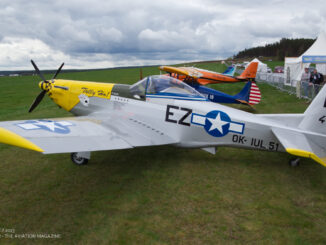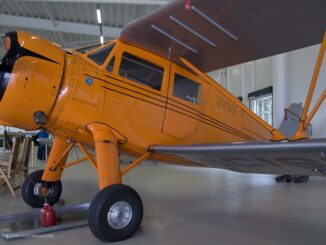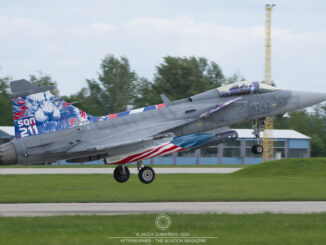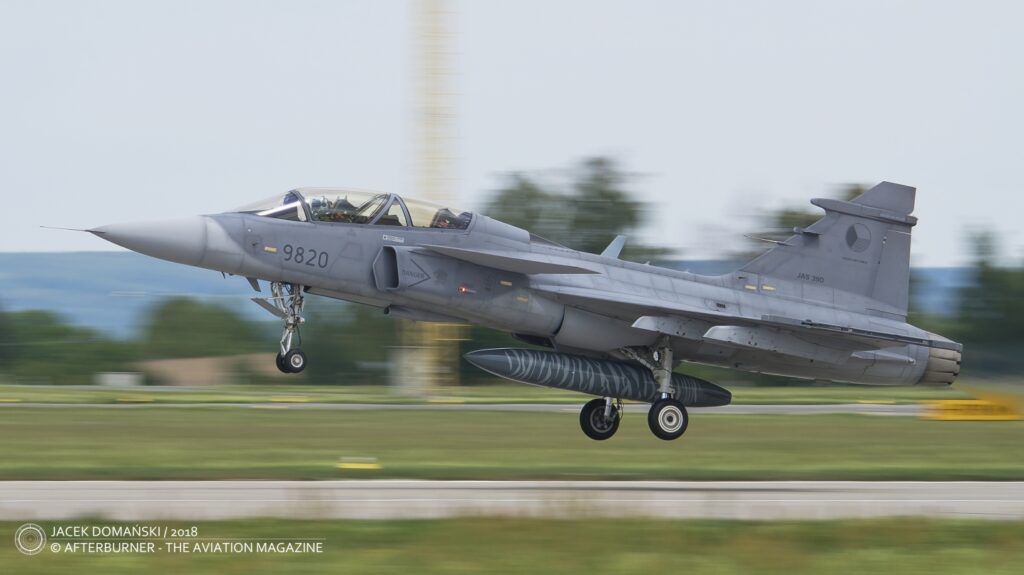 Seventeen years ago, on 18th April 2005, the first six JAS-39 Gripen aircraft arrived to Čáslav air force base in the Czech Republic, therefore opening the new era in the Czech Air Force. Implementation of the Swedish fighter meant not only a generational change but also, and perhaps above all, switching into Western aviation environment and culture. Now, as the Gripen lease term is slowly coming to its end, the country is again facing the important question about future of its fighter jets.
Seventeen years ago, on 18th April 2005, the first six JAS-39 Gripen aircraft arrived to Čáslav air force base in the Czech Republic, therefore opening the new era in the Czech Air Force. Implementation of the Swedish fighter meant not only a generational change but also, and perhaps above all, switching into Western aviation environment and culture. Now, as the Gripen lease term is slowly coming to its end, the country is again facing the important question about future of its fighter jets.
It was the year 1999 when Czech Republic, Poland and Hungary joined NATO. At that time all those countries were still operating a significant number of post-Soviet aircraft. However, with their accession to the Alliance it became clear that, in a relatively short time, they all should be replaced by aeroplanes of the Western origin. Nevertheless, when it came to acquire the new aircraft, each of the abovementioned countries had decided to go its own way.
Poland started from retiring all remaining MiG-23 aircraft (NATO reporting name ´Flogger´) but then acquired even more MiG-29 (´Fulcrum´) fighters from the Czech Republic and Germany. As the next step, all MiG-21 jets (´Fishbed´) were withdrawn from active service. Parallelly, discussion about the new fighter aeroplane was opened and shortly thereafter, the bid for new jet was organized. Among its participants there were F-16 Fighting Falcon, Mirage 2000 and the JAS-39 Gripen.
The winner of Polish tender was officially announced in 2002. It was, as it was forecasted from the beginning, the F-16 Block 52+ with a total number of 48 aircraft in C and D version to be purchased. Their deliveries started in 2006 but, despite implementing the new American-made fighter, some MiG-29s remained with the Polish Air Force, being still in active service until today.
At the time Hungary joined the Alliance, the Hungarian Air Force was operating approximately twenty MiG-29 fighters. They were relatively new and acquired just six years earlier. Despite that, change to the new, NATO-compatible fighter became a matter of urgency there. Several aviation manufacturers were interested in Hungarian bid; however, the choice was finally made between the F-16 and the Gripen, in favour of the latter.
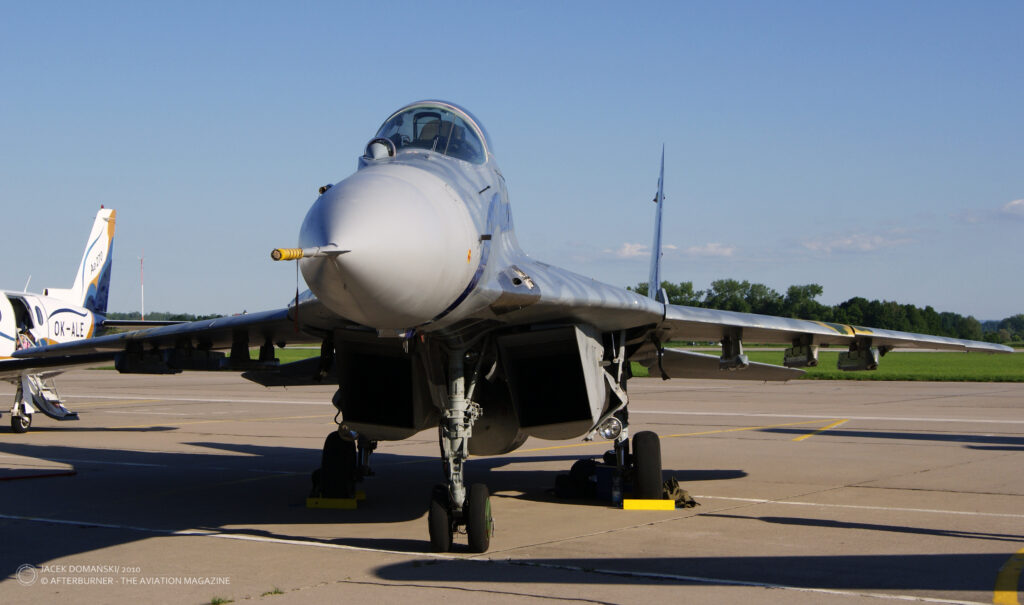
In 2001, the Hungarian government approved long-term leasing of fourteen examples of the JAS-39 Gripen aircraft (12 single-seat C version and 2 two-seat D version). All those fighters were delivered by the end of 2007. Five years later, the initial leasing term was extended until 2026.
Czech way to the Western fighter was, most probably, the most difficult one. After dissolution of Czechoslovakia, the newly established republic received – from the inventory of former Czechoslovak Air Force – both MiG-21, MiG-23 and MiG-29 aircraft. Although, among them, the MiG-29s were the newest type, it was almost impossible to keep them operational. All training and maintenance facilities were now located in Slovakia and access to spare parts was complicated for political reasons. Eventually in 1995, all ten Czech ´Fulcrums´ were sold to Poland, in exchange for eleven W-3A Sokół helicopters.
The fighter variants of MiG-23 were successively withdrawn from active service. Since 1998, the Czech fighter aviation consisted entirely of, already obsolete, MiG-21MF and MiG-21MFN jets that were manufactured yet in the 1970s.
Discussion on the future Czech fighter was long and complicated, so were following negotiations with aviation manufacturers. Initially, twenty four aircraft were planned to be acquired, nevertheless troubled financial situation caused by flood of 2002 led to reduction of that number. Only in 2004 an agreement was signed between Czech and Swedish governments on subject of long-term financial lease of fourteen JAS-39 Gripen aircraft. Similarly to Hungary, the Czech Air Force had to receive 12 single-seat C version and 2 two-seat D version aeroplanes. As mentioned at the beginnig, the first Gripens arrived in 2005 and all leased aircraft were assigned to the 211th Tactical Squadron based in Čáslav.
The cost of acquiring the new fighters was approximately 20 billion CZK (850 million USD) and covered lease of fourteen aircraft for a fixed period of ten years, including support and service. Additional 150 million CZK were spent for flying and ground crew training in Sweden. An interesting fact is that, among additional conditions of the agreement, there was restriction of use, allowing each aircraft to fly just approximately 150 flying hours per year (21,000 flying hours in total). After expiry of the lease term, the Czech Republic could either buy out the Gripens or return the aircraft to manufacturer.
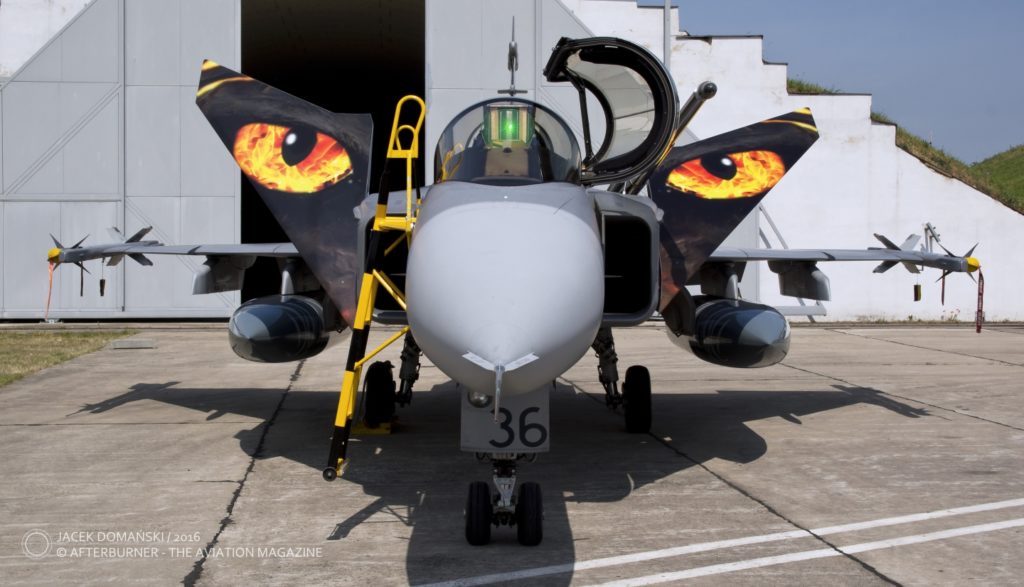
Although initially the Gripens were received with just their basic configuration, they still meant a milestone for the Czech Air Force. The JAS-39 was much more advanced than the MiG-21MF, had opened several new opportunities and, above all, allowed the full transition into NATO structures.
Nevertheless, the basic software version – known as MS18.5 or MS18 Block 5 – allowed the Czech aircraft only to join the NATINAMDS (NATO Integrated Air and Missile Defence System) structure, thus replacing the MiG-21 in its role of air defence fighter. Shortly thereafter, it turned out that situation was not meeting the expectations of the Czech Air Force and, as a consequence, the Czech JAS-39s underwent several modifications and upgrades – enhancing their operational capabilities and armament. Obviously, costs of all modernizations were borne by the Czech Republic. For example, just implementation of AIM-120C AMRAAM missiles meant additional 750 million CZK.
In 2007, the Czech Gripens for the first time participated in international live-fly exercise – Operational Integration Exercise 2007 in Belgium, and two years later were deployed to Baltic countries within their first NATO air policing mission. It was a good start of active international cooperation within structures of the Alliance. During the following years, the Czech Gripens participated in many foreign operations and live-fly trainings, including Baltic and Icelandic Air Policing, NATO Tiger Meets, Operation Unified Protector, Lion Effort and Sky Avenger exercises and many more. In 2010, the 211th Squadron was awarded the Full Membership in the ´NATO Tigers´ association.
In 2010, the fleet of JAS-39 fighters achieved a total number of 10,000 flying hours. One year later, the first Czech pilot reached the milestone of 1,000 flying hours with Gripen.
In 2015, the initial lease term was extended until 2027, with an additional option for another two years. The value of that extension was 19,6 billion CZK for the aircraft and 1,8 billion CZK for additional training and further upgrades to MS20 and MS20 Block 2 standards. It must be noted that at the time of lease extension, the JAS-39 fleet was at the point of their flight hours limit set in the initial agreement.
In 2020, symbolically on the Veteran Day, the Czech Gripens achieved another milestone of 30,000 flying hours in total.

Although it seemed to be far too early, the question of future Czech fighter started to be a subject of political debate already in 2019. It quickly was dragged into public discussion due to some media stories which clearly indicated – usually following some unnamed sources in the USA – that the Czech Republic was interesting in purchasing dozens of American fighters.
At that time, the Czech military authorities officially acknowledged that the future of country´s fighter aviation was discussed internally, although being still confidential and with conclusion to be expected not earlier than in the end of 2021. Moreover, shortly after the country was on the eve of parliamentary election with expected significant change in the political climate, thus any decision related to the future of the fighter aviation was left for the new government.
Irrespective of any speculations, there were just three possible scenarios for the period beyond 2027. The first of them was to buy out the Gripens after expiring of the lease agreement – but to keep them operational for another decade or so, a complicated and expensive upgrade would be needed.
It was estimated that at expiration of the lease, the Czech Gripens should already clock over 4,000 flying hours per aircraft. This, together with necessity of keeping their software and armament up to date, would require spending significant amount of money on the upgrade. Moreover, it would be done solely for the Czech aeroplanes, because the SAAB company was not planning any common modification programme for C/D version. Instead of that, the new and more advanced variant of the fighter was implemented, the Gripen E.
Nevertheless, introducing the new Gripen into the Swedish Air Force would mean that some additional aircraft of earlier variants would be retired and then available on the market, to be purchased at a reasonable price. That could create an opportunity to increase the number of Gripens with the Czech Air Force for a relatively low cost, and in the next step, decide about the scope of their modernization.
Another solution was to end the existing agreement, return the aircraft to manufacturer and, at the same time, conclude another lease but for the Gripen E. Back in 2019 and 2020, it seemed the most reasonable option that would allow to keep existing facilities and use experiences already gained with fifteen years of operating the JAS-39 fighters.

Finally, there was the third scenario that assumed the Gripens should be retired from the Czech Air Force and replaced by another fighters. In particular, the latter solution launched a wave of speculations that swept through Czech media. Several analyses and research articles were published, all focusing on the best possible fighter for the Czech Air Force. Certainly, some authors let their imagination run wild, mentioning literally all fighters manufactured at that time – from the F-16, through F-35 Lightning II and F-15, to Rafale and Eurofighter.
Also in 2019, the first rumours related to the F-35 were heard from the Czech military. Some of high-ranked authorities were not concealing that their ambition was to acquire the 5th generation fighter. Although, that solution was usually considered as the last likely of all possible outcomes, mainly due to the cost of such purchase.
However, things seemed to change at the end of 2021. Along with increasing political tensions in Europe and the advent of new Czech government, news about possible acquire of the American fighter became more and more frequent. The only difference was if they presented the F-16 or the F-35 as the future Czech jet.
Outbreak of the war in Ukraine caused another acceleration in the case of the new Czech fighter jet, increasing the public discussion on the subject. In the spring of 2022, the Czech Ministry of Defence clearly indicated that the country is really interested in increasing the number of its fighters up to twenty four aircraft. Nevertheless, no further details were yet disclosed and the entire procedure of choosing the future fighter was classified.
Once again, the domestic media focused on the case but this time unambiguously suggesting that the choice was already made, and the future Czech fighter would be made in the USA. A few weeks later, they were almost certain it would be the F-35.
Their opinions were often based on information published via official military profiles in the social media. One of such examples was a post released by ´ArmadaČR´ (Czech armed forces), official armed forces account on Twitter. ´A huge technological milestone. Seventeen years ago, obsolete MiG-21s were replaced by Gripens but now there is again a time to move forward´, it said and that was quickly interpreted as clear indication that the 5th generation jet was coming. Nevertheless, the Army distanced itself from such possibility, saying it was just a general information without any deeper meaning hidden behind.
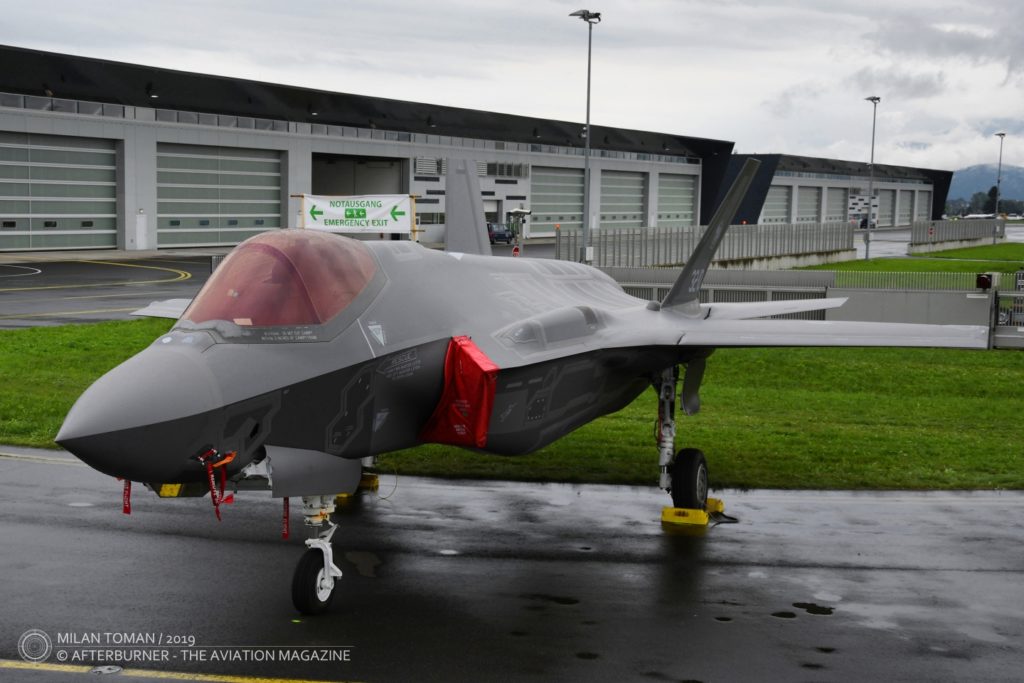
In recent days, number of publications in domestic media related to the future Czech fighter jet had significantly increased. What´s more, they usually emphasize the fact that the Gripen was developed yet during the Cold War years, therefore having no potential for any further modernizations and even the latest E variant is not meeting the requirements of the future battlefield. At the same time, advantages of the 5th generation jet are pointed.
Obviously, there is no simple answer to the question of the future fighter aircraft for the Czech Air Force. Both the Gripen and the F-35 have some arguments for and against. First of all, almost fifteen years of the JAS-39 service with the Czech Air Force created a certain level of knowledge and experience, being a solid base for introducing the Gripen E.
Moreover, if the operational tasks of the Czech Air Force remain the same as they were in the past two decades, the Gripen seems to be perfectly tailored for them – being a smart alternative for more expensive, two-engine fighters. It can perform all classic fighter duties, has additional close-support capability, as well as can be used for air policing missions. In addition, the SAAB company emphasizes very short time needed to rearm and refuel the Gripen in any environment, as well as its user-friendliness in daily maintenance.
The F-35 Lightning II is indeed significantly more expensive in purchase and maintenance than the Gripen but features a completely different level of capabilities, beyond the scope of a classic fighter. That aircraft should be used as a multifunction digital platform, broadly cooperating with other branches of armed forces. However, there is a condition that the other military equipment must be at the same level of digitalisation as the F-35, assuring effective data exchange with the aircraft and thus enhancing abilities of all weapons as a coherent system.
The 5th generation fighter and its stealth capability are tailored for operations in digital combat environment and over areas with advanced multi-level anti-air defence. Using the F-35 solely for classic airspace protection duty or air policing missions is merely a waste of taxpayers´ money.

Therefore, the question is now not only about selection of the new fighter but also, and most of all, about the future of the Czech Air Force and its mission. In recent days, the Czech government several times mentioned about their intention to increase the country´s contribution to the Alliance and its operations in the nearest future. It included possibility to obtain status of frontline NATO country and, for that purpose, the F-35 seems to be the better choice.
Nevertheless, it should not be forgotten that switching to the next generation fighter, together with increased participation in the NATO operations requires much more financial resourced to be assigned for the military than ever before. And this is not only about higher cost of the fighter itself or expenditures per flying hour. As already mentioned, the 5th generation aircraft requires large investment in other branches of the armed forces. The entire military structure in the country must be upgraded, just to be able to use the maximum potential of the new airborne platform.
In this situation, operational expenses for twenty four F-35 Lightning II jets, estimated at 12 billion CZK per annum – as repeated by the local press – seems to be insufficient. For the sake of comparison, just the lease of 14 Gripen jets costs, following the price agreed in 2015, 1,7 billion CZK per annum.
Nevertheless, the General Staff of the Czech armed forces had already submitted their recommendation about the future fighter jet (although still being classified). Now, the MoD should forward this recommendation to the government, together with their comments – this is expected to happen yet this month. The final decision should be made by the Czech government until the end of August and, most probably, only then will be disclosed to public.
It seems that the decision about the future jet fighter for the Czech Air Force would be a resultant of many factors, including the political ones. There will be ambitions of high-ranked military and some politicians that would like to have the most modern jet currently available. Then there will be political interference and usual lobbying of aviation manufacturers, as well as current geopolitical situation in Europe and forecast for the future. And, finally, there will be budgetary possibilities and potential support from the Alliance or the USA.
Certainly, there is also another way. Despite the fact that for almost a year the public discussion is focused on the Gripen and the F-35, the choice can be completely different and the F-16 Fighting Falcon may be the dark horse here.


